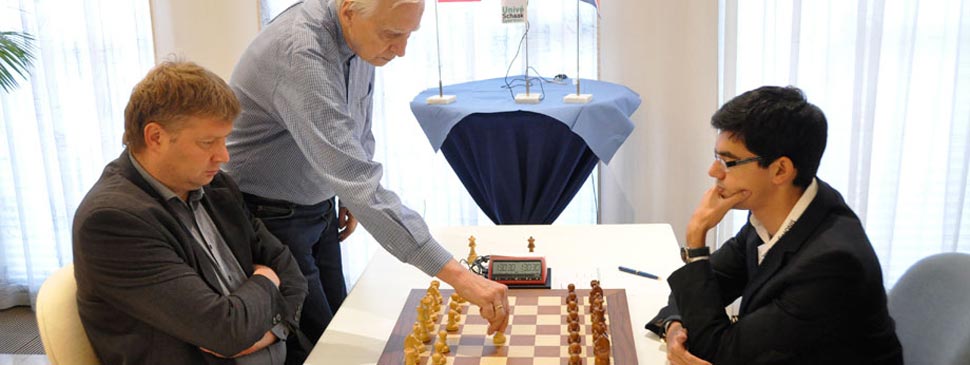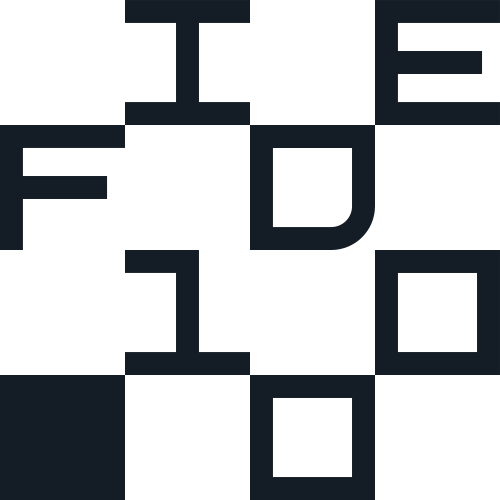At two in the afternoon it started. Former chairman of the Dutch House of Commons, Dick Dolman, made the first move on both boards of the matches in the Glass Room of the town hall. And the four matadors immediately went for it. Timman and Jobava played a highly interesting opening where the Dutchman got the upper hand, but at a crucial moment he chose to play it safe. Alexey Shirov almost immediately went for Anish Giri’s throat, but the Dutch number 7 of the world countered very cleverly and made the first try, as they say in rugby.
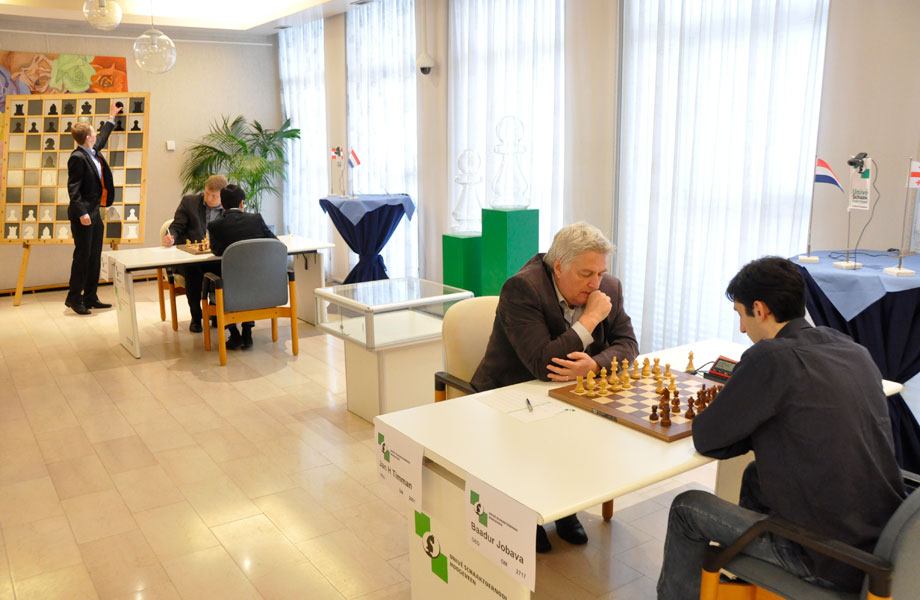
Timman - Jobava
1.d4 Nf6 2.c4 e6 3.Nf3 Bb4+ 4.Bd2 Bxd2+ 5.Qxd2 d5 6.g3 Nbd7 7.Bg2 c6
This set-up was often employed by Ulf Andersson in the 1980’s. Through the years, Jobava played it several times as well, but no-one had played the most popular move against him:
8.0–0 dxc4 9.a4 Rb8 10.Rc1 b6
In order to meet the natural 11.Na3 with 11...b5!.
11.Rxc4 c5
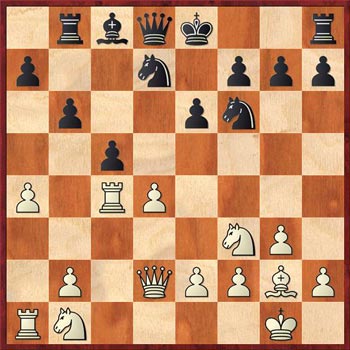
12.b4
A nice, thematic move, which removes the white weaknesses on the b-file and piles up the pressure.
12...Ba6 13.Rc2
After 13.b5 Bb7, c5 is solidly protected and Black has achieved his aim.
13...cxb4
‘Only move’, said Jobava. The computer also gives 13...0–0 14.dxc5 bxc5 15.bxc5 Ne4 16.Qe3 Nexc5 and due to the check on the bottom rank White cannot take twice on c5.
14.Qxb4 Qe7 15.Qa3 Bb7 16.Nbd2

It looks pretty unpleasant for Black. He cannot ‘pass’ anymore.
16...Qxa3 17.Rxa3 Ke7 18.Ne5 Bxg2 19.Kxg2 Rhc8
A tactical save. After 19...Rb7 20.Nc6+ Kf8 21.a5 White is clearly better, and after 19...Rbc8? 20.Nc6+ Kf8 21.Rac3 the queen’s rook is too passive.
20.Nc6+ Ke8
‘Here I had to choose’, Jobava said. ‘If I play 20...Kf8, then follows 21.Rac3 Tb7 22.Nb4 and White occupies the c-file. If I put my king on e8, it can always go to d8 later. White’s next move looked dangerous.’
21.e4 Ra8 22.e5 Nd5 23.Ne4 Rc7 24.Nd6+ Kf8

Here Timman went for the draw with...
25.Nb5 Rcc8 26.Nd6 Rc7 27.Nb5
‘I didn’t see how to make progress’, he said. ‘Certainly in the first game of such a match it seemed unwise to take risks.’ Jobava also thought that other attempts by White would be risky, for example: 27.a5 Nb8 28.axb6 Nxb6 29.Nb4 Rxc2 30.Nxc2 a5 and White has to reckon with Black’s passed pawn.
‘Actually it was quite a normal game’, Jobava said. Yet another unique happening in this tournament: Jobava never plays normal games! In any case, the heartbeat of the Georgian didn’t show any significant ups or downs today.
Video: Peter Doggers

The second game started very quietly, but that didn’t last long. After this big fight, Anish Giri was immediately severely questioned by Jan Gustafsson and Paco Vallejo Pons on Chess24.
Shirov - Giri
1.e4 e5 2.Nf3 Nc6 3.Bc4 Bc5 4.d3 Nf6 5.Nc3 d6
Giri: ‘From the beginning I thought I was okay. He copied my moves. Of course he had one tempo more.’ When Jop Delemarre asked in the commentary room why it’s always Black who has to deviate in symmetrical positions, someone in the audience answered philosophically: ‘Because White cannot.’
Why don’t you take a break and let this sink in for a while. In any case, Giri followed Delemarre’s Law:
6.0–0 Na5 7.Bb3 a6
Preventing White from copying with 8.Na4.
8.d4!?
Surprising, and not so good according to Gusty. However, Giri had expected this move: ‘Otherwise I just take the bishop. I’ve had 8.Le3 and 8.Lg5, both in games with Harikrishna. I learned a lot from this ‘trainer’.
8...Nxb3 9.axb3 exd4 10.Nxd4 h6

11.Nf5
Giri had expected this as well: ‘Otherwise I just castle, and, well, I’ve got the bishop pair.’ ‘So you also expected him to lose?’ Gusty snapped, and this was the start of an entertaining bit of trash talk on Skype.
11...Bxf5 12.exf5 0–0 13.g4
This may have been a little premature. On 13.Qf3 Giri wanted to play 13...d5 and consolidate.
13...Qd7
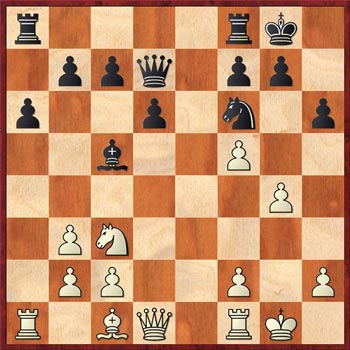
A pretty provocative move, because White’s answer looks strong.
14.Nd5!? Nxd5 15.Qxd5 Qb5!
‘I had underestimated this move’, Shirov admitted. ‘After this I’m already fighting for a draw, try to survive. Right after the opening…’
16.Qf3 Rfe8 17.Kg2
After 17.c4 Qc6 Black can already enter a favourable endgame, since after 18.Qxc6 bxc6 there follows 19...Reb8 and the b-pawn cannot be saved. But allowing the queen on e2 is no picnic either.
17...Qe2 18.c3 Re4 19.Ra4 Rae8 20.Rxe4 Rxe4

21.h3
For a long time the players analysed the alternative 21.Bf4, which was better according to Giri. The bishop goes to g3 and protects f2, and ...d6-d5 is less strong because c7 is hanging. Black replies with 21...a5 (to prevent 22.b4) and then 22...Re8!. ‘I would have had to find that move’, said Giri.
21...d5 22.b4 Bb6
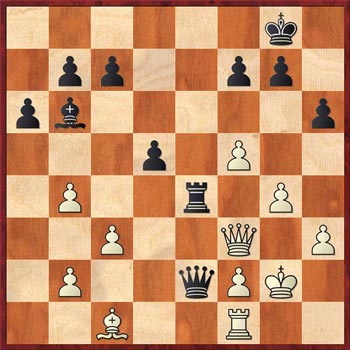
23.f6
Fighting fire with fire. Shirov thought that the to-and-fro-move 23.Rg1 would still have given him some drawing chances. Giri also thought that things weren’t so terrible for White: ‘Perhaps he should just have exchanged the queens.’
23...g5 24.Qf5 Re5 25.Qc8+ Kh7!

26.Qf8
Giri was temporarily shocked when he saw the treacherous 26.Be3!?, until he found the nice variation 26...Rxe3 27.Qf8 Qf3+ 28.Kg1 Qg3+! 29.fxg3 Re8+ 30.Qc5 Bxc5+ 31.bxc5 Re2 with a winning rook endgame.
26...Qe4+ 27.Kg3 Qg6 28.f4 gxf4+
A second trick: not the originally planned 28...Qxf6 in view of 29.fxg5! Qxf1 30.g6+! and White wins!
29.Bxf4 Re2
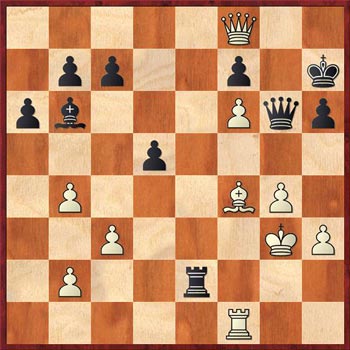
30.Bxh6
Shirov prefers to go down in fireworks. The queen ending after 30.Bc1 Be3 31.Bxe3 Rxe3+ 32.Rf3 Rxf3+ 33.Kxf3 Qxf6+ was winning according to Giri.
30...Qxh6 31.Qxf7+ Kh8 32.Rf3 Bg1! 33.h4
More chances would have been offered by 33.Rd3 Re3+ 34.Rxe3 Qxe3+, but this has to be winning for Black.
33...Bh2+ 34.Kh3 Bd6
And resigned. White has to exchange the queens and the endgame offers no more chances.
Video: Peter Doggers
And so, tournament director Loek van Wely hadn’t exaggerated when he said he expected the matches would bring a lot of spectacle. We can hardly wait until the following round.


 .
. 
